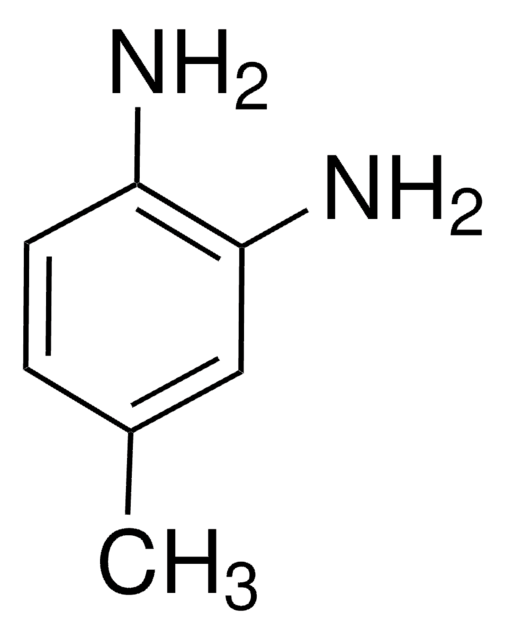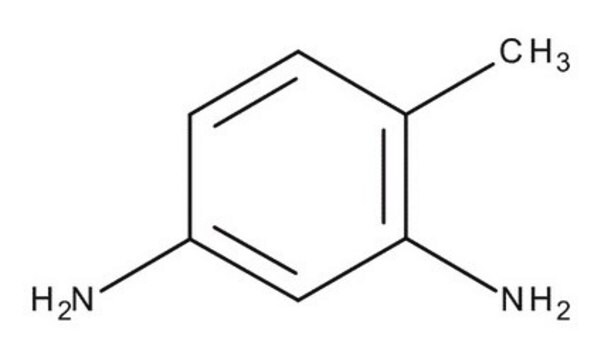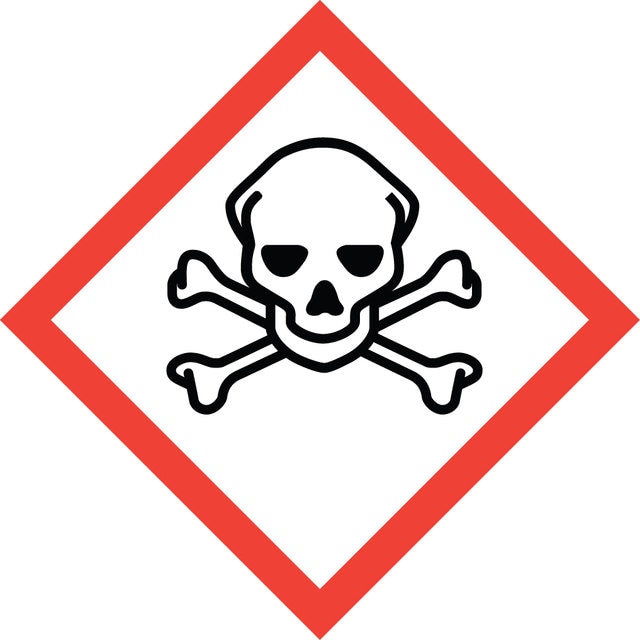101915
2,4-Diaminotoluene
98%
동의어(들):
4-Methyl-m-phenylenediamine, 2,4-Diaminotoluene, 2,4-Toluenediamine, 4-Methyl-1,3-phenylenediamine
로그인조직 및 계약 가격 보기
모든 사진(1)
About This Item
Linear Formula:
CH3C6H3(NH2)2
CAS Number:
Molecular Weight:
122.17
Beilstein:
2205839
EC Number:
MDL number:
UNSPSC 코드:
12162002
PubChem Substance ID:
NACRES:
NA.23
추천 제품
Quality Level
분석
98%
양식
solid
bp
283-285 °C (lit.)
mp
97-99 °C (lit.)
SMILES string
Cc1ccc(N)cc1N
InChI
1S/C7H10N2/c1-5-2-3-6(8)4-7(5)9/h2-4H,8-9H2,1H3
InChI key
VOZKAJLKRJDJLL-UHFFFAOYSA-N
유사한 제품을 찾으십니까? 방문 제품 비교 안내
애플리케이션
- Employing UV/H2O2 process for degradation of 2, 4-Diaminotoluene in synthetic wastewater: This study explores the degradation of carcinogenic Toluene-2, 4-diamine in synthetic wastewater using the UV/H2O2 process, highlighting its potential for improving water treatment methods (J Hosseini, A Shokri, 2017).
- Development of magnetic, ferrite supported palladium catalysts for 2, 4-dinitrotoluene hydrogenation: The paper discusses the use of Pd/NiFe2O4 catalyst for efficient hydrogenation of 2,4-dinitrotoluene to 2,4-diaminotoluene, demonstrating a high yield and potential for industrial applications (V Hajdu, M Varga, G Muránszky, G Karacs, 2021).
- Synthesis, characterisation and energetic performance of insensitive energetic salts formed between picric acid and 2, 3-diaminotoluene, 2, 4-diaminotoluene: This paper presents the synthesis and characterization of new energetic materials, which could be significant for the development of safer explosives and pyrotechnic devices (N Şen, H Nazir, N Atҫeken, KS Hope, N Acar, 2020).
신호어
Danger
유해 및 위험 성명서
Hazard Classifications
Acute Tox. 3 Dermal - Acute Tox. 3 Oral - Aquatic Acute 1 - Aquatic Chronic 2 - Carc. 1B - Muta. 2 - Repr. 2 - Skin Sens. 1 - STOT RE 2
표적 기관
Liver,Kidney
Storage Class Code
6.1C - Combustible acute toxic Cat.3 / toxic compounds or compounds which causing chronic effects
WGK
WGK 3
Flash Point (°F)
320.0 °F - closed cup
Flash Point (°C)
160 °C - closed cup
개인 보호 장비
Eyeshields, Faceshields, Gloves, type P3 (EN 143) respirator cartridges
Pei-Shan Liu et al.
Toxicology, 219(1-3), 167-174 (2005-12-13)
Toluene diisocyanate (TDI) is widely used as a chemical intermediate in the production of polyurethane. TDI-induced asthma is related to its disturbance of acetylcholine activity in most affected workers, but the relevant mechanisms are unclear. Toluene diamine (TDA) is the
Astrid Rohrbeck et al.
Toxicological sciences : an official journal of the Society of Toxicology, 118(1), 31-41 (2010-08-18)
Information on the carcinogenic potential of chemicals is primarily available for High Production Volume (HPV) products. Because of the limited knowledge gain from routine cancer bioassays and the fact that HPV chemicals are tested only, there is the need for
Kazunori Narumi et al.
Mutation research, 747(2), 234-239 (2012-06-09)
Various liver micronucleus assay methods, such as those involving partial hepatectomy, treatment with mitogens, and the use of juvenile animals, have been developed. These assays have been proven to be of high sensitivity and specificity to predict hepatocarcinogenicity of compounds
Isabelle Séverin et al.
Toxicology, 213(1-2), 138-146 (2005-07-06)
2,4-Diaminotoluene (2,4-DAT) is a widely used industrial intermediate and human exposure is possible in the dye and plastics industries. We investigated the genotoxicity of the environmental pollutant, 2,4-DAT, in human HepG2 cells using the unscheduled DNA synthesis (UDS) test, the
Jeroen A J Vanoirbeek et al.
Toxicological sciences : an official journal of the Society of Toxicology, 109(2), 256-264 (2009-04-01)
Toluene diamine (TDA) is formed when toluene diisocyanate (TDI), a potent sensitizer, comes in contact with an aqueous environment. The sensitizing capacity of TDA and the cross-reactivity between TDI and TDA are unknown. TDA (5-25%) and TDI (0.3%), dissolved in
프로토콜
GC Analysis of Anilines on Equity®-5
자사의 과학자팀은 생명 과학, 재료 과학, 화학 합성, 크로마토그래피, 분석 및 기타 많은 영역을 포함한 모든 과학 분야에 경험이 있습니다..
고객지원팀으로 연락바랍니다.








